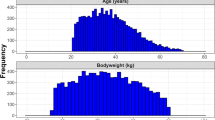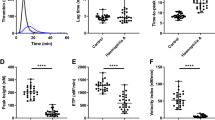Abstract
Emicizumab reduces bleeding in hemophilia A patients with inhibitor (HA-inh). A combination of immune tolerance induction therapy (ITI) and emicizumab prophylaxis may provide additional benefits, but coagulation potential during this treatment remains unknown. We assessed coagulation potentials in simulated ITI models in vitro using modified-clot waveform analysis. Factor (F)VIII-deficient plasma preincubated with anti-A2 and anti-C2 monoclonal antibodies was reacted with emicizumab (50 µg/mL) (emicizumab–HA–plasma), then spiking bypassing agents (BPAs): activated prothrombin complex concentrates (aPCC 1.3 IU/mL; 50 IU/kg), recombinant factor (rF)VIIa (2.2 µg/mL; 90 µg/kg), and FVIIa/FX (1.5 µg/mL; 60 µg/kg), and/or FVIII (100, 200 IU/dL). Coagulation potentials in emicizumab–HA–plasma (10 BU/mL) remained within the normal range when BPA and FVIII were both present. In emicizumab–HA–plasma (1 BU/mL) with BPA and FVIII (200 IU/dL), they were near or beyond the normal range, but those with a half concentration of rFVIIa based on the half-life in blood were within the normal range. In samples without inhibitor, coagulation potentials with combined BPA and FVIII were far beyond the normal range but with FVIII (100 IU/dL) and rFVIIa at half concentration they remained within the normal range. These results may provide information on the feasibility of concurrent ITI under emicizumab prophylaxis.




Similar content being viewed by others
References
Manco-Johnson MJ, Abshire TC, Shapiro AD, Riske B, Hacker MR, Kilcoyne R, et al. Prophylaxis versus episodic treatment to prevent joint disease in boys with severe hemophilia. N Engl J Med. 2007;357:535–44.
Gouw SC, van der Bom JG, Ljung R, Escuriola C, Cid AR, Claeyssens-Donadel S, PedNet and RODIN Study Group, et al. Factor VIII products and inhibitor development in severe hemophilia A. N Engl J Med. 2013;368:231–9.
Walsh CE, Jiménez-Yuste V, Auerswald G, Grancha S. The burden of inhibitors in haemophilia patients. Thromb Haemost. 2016;116(Suppl 1):S10–7.
Shinkoda Y, Shirahata A, Fukutake K, Takamatsu J, Shima M, Hanabusa H, et al. A phase III clinical trial of a mixture agent of plasma-derived factor VIIa and factor X (MC710) in haemophilia patients with inhibitors. Haemophilia. 2017;23:59–66.
Astermark J, Rocino A, Von Depka M, van den Berg HM, Gringeri A, Mantovani LG, EHTSB, et al. Current use of by-passing agents in Europe in the management of acute bleeds in patients with haemophilia and inhibitors. Haemophilia. 2007;13:38–45.
Berntorp E. Differential response to bypassing agents complicates treatment in patients with haemophilia and inhibitors. Haemophilia. 2009;15:3–10.
Ogiwara K, Nogami K, Matsumoto T, Shima M. Tissue factor pathway inhibitor in activated prothrombin complex concentrates (aPCC) moderates the effectiveness of therapy in some severe hemophilia A patients with inhibitor. Int J Hematol. 2014;99:577–87.
Wight J, Paisley S, Knight C. Immune tolerance induction in patients with haemophilia A with inhibitors: a systematic review. Haemophilia. 2003;9:436–63.
Oldenburg J, Schwaab R, Brackmann HH. Induction of immune tolerance in haemophilia A inhibitor patients by the ‘“Bonn Protocol”’: predictive parameter for therapy duration and outcome. Vox Sang. 1999;77(Suppl. 1):49–54.
Freiburghaus C, Berntorp E, Ekman M, Gunnarsson M, Kjellberg B, Nilsson IM. Tolerance induction using the Malmö treatment model 1982–1995. Haemophilia. 1999;5:32–9.
Mauser-Bunschoten EP, Nieuwenhuis HK, Roosendaal G, van den Berg HM. Low-dose immune tolerance induction in hemophilia A patients with inhibitors. Blood. 1995;86:983–8.
Mariani G, Kroner B, Immune Tolerance Study Group (ITSG). Immune tolerance in hemophilia with factor VIII inhibitors: predictors of success. Haematologica. 2001;86:1186–93.
DiMichele DM, Kroner BL, North American Immune Tolerance Study Group. The North American Immune Tolerance Registry: practices, outcomes, outcome predictors. Thromb Haemost. 2002;87:52–7.
Haya S, Lopez MF, Aznar JA, Batlle J, Spanish Immune Tolerance Group. Immune tolerance treatment in haemophilia patients with inhibitors: the Spanish Registry. Haemophilia. 2001;7:154–9.
Lenk H, ITT Study Group. The German registry of immune tolerance treatment in hemophilia—1999 update. Haematologica. 2000;85(10 Suppl):45–7.
Coppola A, Margaglione M, Santagostino E, Rocino A, Grandone E, Mannucci PM, AICE PROFIT Study Group, et al. Factor VIII gene (F8) mutations as predictors of outcome in immune tolerance induction of hemophilia A patients with high-responding inhibitors. J Thromb Haemost. 2009;7:1809–15.
Nogami K, Taki M, Matsushita T, Ohga S, Oka T, Horikoshi Y, et al. The Japanese Immune Tolerance Induction (J-ITI) study in haemophilia patients with inhibitor: outcomes and successful predictors of ITI treatment. Haemophilia. 2018;24:e328–37.
Carpenter SL, Khair K, Gringeri A, Valentino LA. Prophylactic bypassing agent use before and during immune tolerance induction in patients with haemophilia A and inhibitors to FVIII. Haemophilia. 2018;24:570–7.
Kitazawa T, Igawa T, Sampei Z, Muto A, Kojima T, Soeda T, et al. A bispecific antibody to factors IXa and X restores factor VIII hemostatic activity in a hemophilia A model. Nat Med. 2012;18:1570–4.
Sampei Z, Igawa T, Soeda T, Okuyama-Nishida Y, Moriyama C, Wakabayashi T, et al. Identification and multidimensional optimization of an asymmetric bispecific IgG antibody mimicking the function of factor VIII cofactor activity. PLoS ONE. 2013;8:e57479.
Shima M, Hanabusa H, Taki M, Matsushita T, Sato T, Fukutake K, et al. Factor VIII-mimetic function of humanized bispecific antibody in hemophilia A. N Engl J Med. 2016;374:2044–53.
Shima M, Hanabusa H, Taki M, Matsushita T, Sato T, Fukutake K, et al. Long-term safety and efficacy of emicizumab in a phase 1/2 study in hemophilia A patients with or without inhibitors. Blood Adv. 2017;1:1891–9.
Oldenburg J, Mahlangu JN, Kim B, Schmitt C, Callaghan MU, Young G, et al. Emicizumab prophylaxis in hemophilia A with inhibitors. N Engl J Med. 2017;377:809–18.
Young G, Liesner R, Chang T, Sidonio R, Oldenburg J, Jiménez-Yuste V, et al. A multicenter, open-label phase 3 study of emicizumab prophylaxis in children with hemophilia A with inhibitors. Blood. 2019;134:2127–38.
Mahlangu J, Oldenburg J, Paz-Priel I, Negrier C, Niggli M, Mancuso ME, et al. Emicizumab prophylaxis in patients who have hemophilia A without inhibitors. N Engl J Med. 2018;379:811–22.
Pipe SW, Shima M, Lehle M, Shapiro A, Chebon S, Fukutake K, et al. Efficacy, safety, and pharmacokinetics of emicizumab prophylaxis given every 4 weeks in people with haemophilia A (HAVEN 4): a multicentre, open-label, non-randomised phase 3 study. Lancet Haematol. 2019;6:e295-305.
Shima M, Nogami K, Nagami S, Yoshida S, Yoneyama K, Ishiguro A, et al. A multicentre, open-label study of emicizumab given every 2 or 4 weeks in children with severe haemophilia A without inhibitors. Haemophilia. 2019;25:979–87.
Nogami K, Shima M. New therapies using nonfactor products for patients with hemophilia and inhibitors. Blood. 2019;133:399–406.
Young G. Implementing emicizumab in hemophilia inhibitor management: emicizumab should be prescribed after tolerance. Blood Adv. 2018;2:2780–2.
Batsuli G, Zimowski KL, Tickle K, Meeks SL, Sidonio RF Jr. Immune tolerance induction in paediatric patients with haemophilia A and inhibitors receiving emicizumab prophylaxis. Haemophilia. 2019;25:789–96.
Dargaud Y, Lienhart A, Janbain M, Quellec SL, Enjolras N, Negrier C. Use of thrombin generateon assay to personalize treatment of breakthrough bleeds in a patient with hemophilia and inhibitors receiving prophylaxis with emicizumab. Haematologica. 2018;103:e181–3.
Furukawa S, Nogami K, Shimonishi N, Nakajima Y, Matsumoto T, Shima M. Prediction of the haemostatic effects of bypassing therapy using comprehensive coagulation assays in emicizumab prophylaxis-treated haemophilia A patients with inhibitors. Br J Haematol. 2020;190:727–35.
Nogami K, Matsumoto T, Tabuchi Y, Soeda T, Arai N, Kitazawa T, et al. Modified clot waveform analysis to measure plasma coagulation potential in the presence of the anti-factor IXa/factor X bispecific antibody emicizumab. J Thromb Haemost. 2018;16:1078–88.
Matsumoto T, Nogami K, Tabuchi Y, Yada K, Ogiwara K, Kurono H, et al. Clot waveform analysis using CS-2000iTM distinguishes between very low and absent levels of factor VIII activity in patients with severe hemophilia A. Haemophilia. 2017;23:e423–35.
Kasper CK, Aledort L, Aronson D, Counts R, Edson JR, van Eys J, et al. A more uniform measurement of factor VIII inhibitors. Thromb Diath Haemorrh. 1975;34:612.
Collins PW, Liesner R, Makris M, Talks K, Chowdary P, Chalmers E, et al. Treatment of bleeding episodes in haemophilia A complicated by a factor VIII inhibitor in patients receiving Emicizumab. Interim guidance from UKHCDO Inhibitor Working Party and Executive Committee. Haemophilia. 2018;24:344–7.
Bravo MI, Raventós A, Pérez A, Costa M, Willis T. Non-additive effect on thrombin generation when a plasma-derived factor VIII/ von Willebrand factor (FVIII/VWF) is combined with emicizumab in vitro. J Thromb Haemost. 2020;18:1934–9.
Nogami K, Soeda T, Matsumoto T, Kawabe Y, Kitazawa T, Shima M. Routine measurements of factor VIII activity and inhibitor titer in the presence of emicizumab utilizing anti-idiotype monoclonal antibodies. J Thromb Haemost. 2018;16:1383–90.
Müller J, Pekrul I, Pötzsch B, Berning B, Oldenburg J, Spannagl M. Laboratory monitoring in emicizumab-treated persons with hemophilia A. Thromb Haemost. 2019;119:1384–93.
Hay CR, DiMichele DM, International Immune Tolerance Study. The principal results of the International Immune Tolerance Study: a randomized dose comparison. Blood. 2012;119:1335–44.
Funding
This work was partly supported by a Grant-in-Aid for Scientific Research (KAKENHI) from the Ministry of Education, Culture, Sports, Science and Technology (MEXT) to KN (Grant No. 18K07885).
Author information
Authors and Affiliations
Contributions
YN designed and performed the experiments, analyzed the data, constructed the figures and wrote the paper; HT performed normal control experiments; MN-S prepared emicizumab, interpreted the data, and supervised this study; KN designed the research, interpreted the data, organized the study, edited the manuscript, and approved the final version to be published.
Corresponding author
Ethics declarations
Conflict of interests
YN and KN receive research support from Chugai Pharmaceutical Co., Ltd. (Chugai), and are engaged in clinical studies sponsored by Chugai and F. Hoffmann-La Roche. KN receives (consulting) honoraria from these companies, and is an inventor of the patents relating to emicizumab. MN-S is an employee of Chugai. HT has no conflict of interest.
Additional information
Publisher's Note
Springer Nature remains neutral with regard to jurisdictional claims in published maps and institutional affiliations.
About this article
Cite this article
Nakajima, Y., Tonegawa, H., Noguchi-Sasaki, M. et al. Predicted coagulation potential using an in vitro simulated model of emicizumab prophylaxis and immune tolerance induction therapy in hemophilia A patients with inhibitor. Int J Hematol 113, 789–796 (2021). https://doi.org/10.1007/s12185-021-03108-8
Received:
Revised:
Accepted:
Published:
Issue Date:
DOI: https://doi.org/10.1007/s12185-021-03108-8




